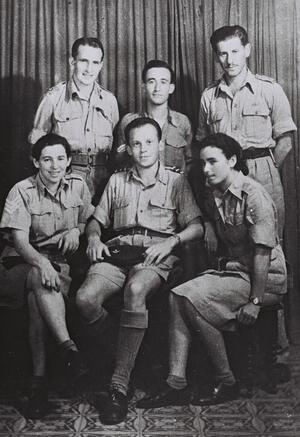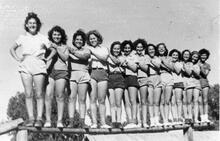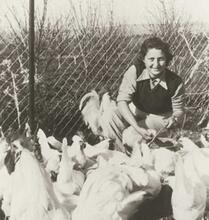Havivah Reik
A soldier and parachutist for Palmah, Havivah Reik risked her life on a secret mission to save thousands of Jews in Slovakia. Source: Wikimedia Commons.
Born to a poor family in a small Slovakian town, Havivah Reik joined the Zionist-socialist movement Ha-Shomer ha-Za’ir and dreamt of making aliyah. She emigrated to Palestine in 1939 and soon met Sara Braverman, who convinced her to join the Palmah, a special force of the underground Haganah. They volunteered for a secret parachuting mission to assist the British war effort and Jewish refugees in Europe. While evacuating thousands of Jewish refugees from an anti-German enclave in November 1944, Reik was captured by Nazi collaborators and murdered; though some of the escaping Jews were captured too, others survived. After the war, their bodies were recovered and reburied in a British cemetery in Prague, but in 1952 Reik’s body was exhumed and reburied on Mt. Herzl in Jerusalem.
Driving along one of Israel’s inner roads in the upper Shomron plain, one passes two settlements with similar names—Givat Havivah and Lahavot Havivah. Both are named after Havivah Reik, one of the seven members of the “Parachutists’ Mission” who lost their lives during World War II while attempting to aid European Jewry under the Nazis.
Early Life
Marta (Havivah) Reik was born in a small Slovakian town in 1914, one of several children in a very poor family. In her youth Reik was a member of the Ha-Shomer ha-Za’ir Zionist-socialist youth movement. Although she wished to continue on towards hakhsharah (agricultural training) in preparation for moving to Palestine, she was forced to delay these plans and aid her family by working as a salesperson in a factory for agricultural machinery. In 1938 Reik finally began her hakhsharah in Bratislava, marrying another young Zionist, Avraham Martinovitch. There are those who claim that it was a fictitious marriage, arranged in order for them to share an immigration certificate, as was common at that time. In 1939 the couple moved to Palestine, joining the Ma’anit A voluntary collective community, mainly agricultural, in which there is no private wealth and which is responsible for all the needs of its members and their families.kibbutz in the Samarian plain.
Just as she had been a pivotal member of Ha-Shomer ha-Za’ir in Slovakia, Reik became an active member of her kibbutz movement after moving to Palestine, coordinating the citrus harvest and engaging in various additional activities in the Karkur settlement, where the kibbutz was located. At a certain point Avraham Martinovitch left the kibbutz, but maintained cordial relations with Reik. Having had several differences of opinion with her kibbutz, Reik moved to kibbutz Shamir, also belonging to the Ha-Shomer ha-Za’ir movement. Here, she met Sara (Surika) Braverman, who persuaded her to join the Palmah.
Special Mission: Saving Slovakian Jews

Six Jewish parachutists in September 1944, including Sara Braverman (front row right) and Havivah Reik (front row left). Source: National Photo Collection of Israel, via Wikimedia Commons.
Upon being approached to join a clandestine project in which Jewish community in Palestine prior to the establishment of the State of Israel. "Old Yishuv" refers to the Jewish community prior to 1882; "New Yishuv" to that following 1882.Yishuv members would be parachuted into Europe in order to aid the British war effort while offering assistance to European Jewry, Reik and Braverman eagerly volunteered their services, taking wireless and paratrooper courses. Late in the summer of 1944 Reik was sent to Bari in Italy to await posting. However, British military rules prohibiting women from participating in “blind drops” forbade Reik to join the Slovakian-bound mission together with her male comrades. “How can I stay here in Bari when there will be no representative of Ha-shomer Ha-Zair among the parachustists?” she said to a friend who tried to convince her that it was fated that she would not leave for the mission, expressing her deep devotion to her pioneering movement. Unwilling to relinquish her mission, Reik found an American military transport bound for the Slovakian town of Banska Bystrica, in the enclave held by anti-German forces, to which the Yishuv parachutists were to make their way, and reached the site before her male comrades.
In Banska Bystrica Reik and her comrades—Rafael Reiss, Haim Hermesh, and Zvi Ben-Ya’akov—made contact with the local Ha-Shomer ha-Za’ir organization and its leader Egon Rot. For six weeks they carried out a double task, helping jettisoned Allied pilots to return home and organizing the thousands of Slovakian Jews who had found refuge in the enclave. Reik was in charge of a large public kitchen, providing sustenance to thousands of hungry, homeless Jews who had fled to Banska Bystrica from all over Slovakia.
Capture and Death
In November 1944, with the changing course of the war, it became necessary to evacuate the settlement at Banska Bystrica in order to escape oncoming German forces. Reik and her comrades had two choices: to take the younger, healthier, fighters to the hills, leaving the masses of Jews to their death, or to try and take the entire group to safety. Although many of the Zionist members preferred the first course, Reik pressed for the latter, ultimately persuading her comrades to take the risk. Upon reaching the Slovakian town of Bukovice, the group was set upon by a unit of Hiwis (Ukranian Nazi collaborators in the S.S.), with only Hermesh managing to escape. Reik and Reiss were brought to prison, while Ben-Ya’akov, who had convinced his captors that he was a British soldier, was kept separately from the group. In the early morning hours of November 20, 1944 Havivah Reik and Rafael Reiss, together with a group of captured Jews, were murdered in the Kremnica forest, their bodies dumped together in a large ditch. Ben-Ya’akov was sent to the Mauthausen camp, where he was ultimately put to death.
After the war, a group of Jews searched for the bodies of the victims and after receiving information about the massacre, unearthed their mortal remains. Reik’s and Reiss’s bodies, identified by the military garb, were exhumed and reburied in the British military cemetery in Prague, with crosses over their graves. In 1949, after many Zionist protests, the crosses were replaced by Stars of David in a military ceremony. Despite the British rule of burying soldiers near their place of death, in a unique move in September 1952 the British War Office permitted the Israeli government to exhume the bodies for reburial in the “Parachutists’ section” at the military cemetery on Mt. Herzl in Jerusalem.
Chermesh, Chaim. Mivtsa’ Amsterdam (Operation Amsterdam). Tel Aviv: Ma’arakhot, 1971.
Ben Nahum, Daniyel, editor. Ke-em hashahle-hatsil: shelihutah shel Havivah Raik (Like a Mother Sensing Rescue: The Mission of Haviva Reik). Tel Aviv: Ha-shomer ha-tsa ir ve-Sifriyat po’alim, 1964.
Benkler, R. “Haviva Reik: Heroine without Heroics.” Israel Horizon 12/10 (December 1964): 15–19.
Gilad, Zerubavel. Magen be-seter (Secret Shield). Jerusalem: ha-Sokhnut ha-Yehudit le’Erets Yisrael, 1952, 547–583.
Ofer, Tehila and Zeev Ofer. Haviva - the Life, Mission and Fall of the paratrooper Haviva Reick (Hebrew). Tel Aviv: Sifriat Poalim, 2004.





